Combined Cultivation Pattern Reduces Soil Erosion and Nutrient Loss from Sloping Farmland on Red Soil in Southwestern China
Abstract
:1. Introduction
2. Materials and Methods
2.1. Study Site Description
2.2. Experimental Design
2.3. Sampling and Measurements
2.4. Data Analyses
- (1)
- The annual total nutrient loss Q (kg·ha−1) was calculated by summing up the losses in all runoff events: Q = Σ Ci × Vi/A ×10−2, where Ci is the TN, TDN, NO3−-N, NH4+-N, TP, or TDP concentration in the runoff water (mg·L−1); Vi is the volume of runoff discharge (L); i = 1~n (n is the number of runoff events in a year) and A is the area of plots (m2).
- (2)
- Average reduction rate ARR (%) = (Average Value OVF − Average Value (other trial plots))/Average Value OVF × 100, where OVF is the control treatment. Average reduction rate was used to compare the average 4-y effects of different treatments for controlling runoff, sediment loss, and nutrient loss relative to the control treatment OVF.
- (3)
- ANOVA was used to assess treatment effects (NVF, OVF, OHF, and OHFR) on runoff depth, sediment loss, nutrient loss by runoff and sediment transport for each runoff event, for each year, and for average reduction rate of entire experimental period from 2014 to 2017. The Tukey test was used to determine if significant differences existed between every two treatments at the 0.05 probability level. Redundancy analysis (RDA) analysis was used to explore impact of factors on N and P loss for different combined cultivation patterns. Statistical analyses were completed with SPSS 17.0 and Canoco 5.0 software.
3. Results
3.1. Runoff and Sediment Loss
3.2. Total Nitrogen and Phosphorus Loss from Runoff and Sediment
3.3. Different Forms of Nitrogen and Phosphorus Loss in Runoff
3.4. Relationship between Runoff Depth and Rainfall, Sediment Loss and Nutrient Loss
3.5. Factors Controlling Nitrogen and Phosphorus Losses
4. Discussion
4.1. Cultivation Pattern Effects on Runoff, Sediment Loss, and Nutrient Loss
4.2. Factors Affecting Nutrient Losses
5. Conclusions
Author Contributions
Funding
Acknowledgments
Conflicts of Interest
References
- Garrity, D.P.; Sajise, P.E. Sustainable land use systems research in Southeast Asia: A regional assessment. In Sustainable Land Use Systems Research and Development; Rodale Press: Emmaus, PA, USA, 1992; pp. 59–76. [Google Scholar]
- Vien, T.D.J.; Leisz, S.; Lam, N.T.; Rambo, A.T. Using Traditional Swidden Agriculture to Enhance Rural Livelihoods in Vietnam’s Uplands. Mt. Res. Dev. 2006, 26, 192–196. [Google Scholar] [CrossRef]
- Partap, T. Hill agriculture: Challenges and opportunities. Indian J. Agric. Econ. 2011, 66, 33–52. [Google Scholar]
- Li, P.; Li, H.; Yang, G.; Zhang, Q.; Diao, Y. Assessing the hydrologic impacts of land use change in the Taihu Lake Basin of China from 1985 to 2010. Water 2018, 10, 1512. [Google Scholar] [CrossRef] [Green Version]
- De Jesús-Crespo, R.; Newsom, D.; King, E.G.; Pringle, C. Shade tree cover criteria for non-point source pollution control in the Rainforest Alliance coffee certification program: A snapshot assessment of Costa Rica’s Tarrazú coffee region. Ecol. Indic. 2016, 66, 47–54. [Google Scholar] [CrossRef]
- Cosentino, S.L.; Copani, V.; Scalici, G.; Scordia, D.; Testa, G. Soil erosion mitigation by perennial species under Mediterranean environment. Bioenergy Res. 2015, 8, 1538–1547. [Google Scholar] [CrossRef]
- Guo, S.F.; Zhai, L.M.; Liu, J.; Liu, H.B.; Chen, A.Q.; Wang, H.Y. Cross-ridge tillage decreases nitrogen and phosphorus losses from sloping farmlands in southern hilly regions of China. Soil Tillage Res. 2019, 191, 48–56. [Google Scholar] [CrossRef]
- Guo, Y.; Liu, S.; Baetz, B.W. Probabilistic rainfall-runoff transformation considering both infiltration and saturation excess runoff generation processes. Water Resour. Res. 2012, 48, 6513. [Google Scholar] [CrossRef] [Green Version]
- Yang, J.L.; Zhang, G.L.; Shi, X.Z.; Wang, H.J.; Cao, Z.H.; Ritsema, C.J. Dynamic changes of nitrogen and phosphorus losses in ephemeral runoff processes by typical storm events in Sichuan Basin, Southwest China. Soil Tillage Res. 2009, 105, 292–299. [Google Scholar] [CrossRef]
- Xia, Y.F.; Zhang, M.; Tsang, D.C.W.; Geng, N.; Lu, D.B.; Zhu, L.F.; Igalavithana, A.D.; Dissanayake, P.D.; Rinklebe, J.; Yang, X.; et al. Recent advances in control technologies for non-point source pollution with nitrogen and phosphorous from agricultural runoff: Current practices and future prospects. Appl. Biol. Chem. 2020, 63, 1–13. [Google Scholar] [CrossRef]
- Xu, W.; Cai, Y.P.; Rong, Q.Q.; Yang, Z.F.; Li, C.H.; Wang, X. Agricultural non-point source pollution management in a reservoir watershed based on ecological network analysis of soil nitrogen cycling. Environ. Sci. Pollut. Res. 2018, 25, 9071–9084. [Google Scholar] [CrossRef]
- Zhang, B.L.; Cui, B.H.; Zhang, S.M.; Wu, Q.Y.; Yao, L. Source apportionment of nitrogen and phosphorus from non-point source pollution in Nansi Lake Basin, China. Environ. Sci. Pollut. Res. 2018, 25, 19101–19113. [Google Scholar] [CrossRef] [PubMed]
- Ma, X.; Li, Y.; Li, B.; Han, W.; Liu, D.; Gan, X. Nitrogen and phosphorus losses by runoff erosion: Field data monitored under natural rainfall in Three Gorges Reservoir Area, China. Catena 2016, 147, 797–808. [Google Scholar] [CrossRef]
- Fan, J.; Yan, L.J.; Zhang, P.; Zhang, G. Effects of grass contour hedgerow systems on controlling soil erosion in red soil hilly areas, Southeast China. Int. J. Sediment Res. 2015, 30, 107–116. [Google Scholar] [CrossRef]
- Vinten, A.J.; Loades, K.; Addy, S.; Richards, S.; Stutter, M.; Cook, Y.; Watson, H.; Taylor, C.; Abel, C.; Baggaley, N.; et al. Assessment of the use of sediment fences for control of erosion and sediment phosphorus loss after potato harvesting on sloping land. Sci. Total Environ. 2014, 468, 1234–1244. [Google Scholar] [CrossRef]
- Liu, Y.; Tao, Y.; Wan, K.Y.; Zhang, G.S.; Liu, D.B.; Xiong, G.Y.; Chen, F. Runoff and nutrient losses in citrus orchards on sloping land subjected to different surface mulching practices in the Danjiangkou Reservoir area of China. Agric. Water Manag. 2012, 110, 34–40. [Google Scholar] [CrossRef]
- Zhang, B.L. Impact on mountainous agricultural development in the Three Gorges Reservoir Area forced by migrants of the Three Gorges Project. Chin. J. Popul. Res. Environ. 2008, 6, 83–89. [Google Scholar]
- Adhikary, P.P.; Hombegowda, H.C.; Barman, D.; Jakhar, P.; Madhu, M. Soil erosion control and carbon sequestration in shifting cultivated degraded highlands of eastern India: Performance of two contour hedgerow systems. Agrofor. Syst. 2017, 91, 757–771. [Google Scholar] [CrossRef]
- Angima, S.D.; Stott, D.E.; O’Neill, M.K.; Ong, C.K.; Weesies, G.A. Use of calliandra-Napier grass contour hedges to control erosion in central Kenya. Agric. Ecosyst. Environ. 2002, 91, 15–23. [Google Scholar] [CrossRef]
- Dabney, S.M.; Wilson, G.V.; McGregor, K.C.; Vieira, D.A.N. Runoff Through and Upslope of Contour Switchgrass Hedges. Soil Sci. Soc. Am. J. 2012, 76, 210–219. [Google Scholar] [CrossRef]
- Mutegi, J.K.; Mugendi, D.N.; Verchot, L.V.; Kungu, J.B. Impacts of vegetative contour hedges on soil inorganic-N cycling and crosional losses in Arable Steep-lands of the Central Highlands of Kenya. In Advances in Integrated Soil Fertility Management in Sub-Saharan Africa: Challenges and Opportunities; Springer: Dordrecht, The Netherlands, 2007; pp. 679–689. [Google Scholar]
- Xia, L.Z.; Liu, G.H.; Ma, L.; Yang, L.Z.; Li, Y.D. The effects of contour hedges and reduced tillage with ridge furrow cultivation on nitrogen and phosphorus losses from sloping arable land. J. Soil Sediment 2014, 14, 462–470. [Google Scholar] [CrossRef]
- Wang, T.; Zhu, B.; Xia, L.Z. Effects of contour hedgerow intercropping on nutrient losses from the sloping farmland in the Three Gorges area, China. J. Mt. Sci. Engl. 2012, 9, 105–114. [Google Scholar] [CrossRef]
- Xia, L.; Hoermann, G.; Ma, L.; Yang, L. Reducing nitrogen and phosphorus losses from arable slope land with contour hedgerows and perennial alfalfa mulching in Three Gorges Area, China. Catena 2013, 110, 86–94. [Google Scholar] [CrossRef]
- Liu, H.T.; Yao, L.; Lin, C.W.; Wang, X.; Xu, W.Z.; Wang, H. 18-year grass hedge effect on soil water loss and soil productivity on sloping cropland. Soil Tillage Res. 2018, 177, 12–18. [Google Scholar] [CrossRef]
- Yang, J.; Zheng, H.; Chen, X.; Shen, L. Effects of tillage practices on nutrient loss and soybean growth in red-soil slope farmland. Int. Soil Water Conserv. Res. 2013, 1, 49–55. [Google Scholar]
- Zhang, J.H.; Frielinghaus, M.; Tian, G.; Lobb, D.A. Ridge and contour tillage effects on soil erosion from steep hillstopes-in the Sichuan Basin, China. J. Soil Water Conserv. 2004, 59, 277–284. [Google Scholar]
- Singh, S.; Brandenburg, N.; Ahiablame, L.; Gonzalez, A.; Kjaersgaard, J.; Trooien, T.P.; Kumar, S. Response of Winter Manure Application on Surface Runoff Water Quantity and Quality from Small Watersheds in South Dakota. Water Air Soil Pollut. 2017, 228, 389. [Google Scholar] [CrossRef]
- Wilson, M.J.; He, Z.L.; Yang, X.E. The Red Soils of China: Their Nature, Management and Utilization; Springer: Dordrecht, The Netherlands, 2004. [Google Scholar]
- Peel, M.C.; Finlayson, B.L.; McMahon, T.A. Updated world map of the Köppen–Geiger climate classification. Hydrol. Earth Syst. Sci. 2007, 11, 1633–1644. [Google Scholar] [CrossRef] [Green Version]
- American Public Health Association. Standard Methods for the Examination of Water and Wastewater, 20th ed.; American Public Health Association: Washington, DC, USA, 1998. [Google Scholar]
- Murphy, J.; Riley, J.R. A modified single solution method for the determination of phosphate in natural waters. Anal. Chim. Acta 1962, 27, 31–36. [Google Scholar] [CrossRef]
- Olsen, S.R.; Sommers, L.E. Methods of Soil Analysis, Part 2; Pages, A.L., Ed.; American Society of Agronomy Inc.: Madison, WI, USA, 1982; pp. 403–429. [Google Scholar]
- Bao, S.D. Agro-Chemical Analysis of Soil (Third Version); Agricultural Publish House of China: Beijing, China, 2000; pp. 1–150. (In Chinese) [Google Scholar]
- Pu, Y.L.; Xie, D.T.; Lin, C.W.; Wei, C.F. Characteristics of soil comprehensive anti-erodibility under sloped cropland with hedgerows. Trans. Chin. Soc. Agric. Eng. 2013, 29, 125–135. (In Chinese) [Google Scholar]
- Sun, H.; Tang, Y.; Xie, J. Contour hedgerow intercropping in the mountains of China: A review. Agrofor. Syst. 2008, 73, 65–76. [Google Scholar] [CrossRef]
- Bouraima, A.K.; He, B.; Tian, T. Runoff, nitrogen (N) and phosphorus (P) losses from purple slope cropland soil under rating fertilization in Three Gorges Region. Environ. Sci. Pollut. Res. Int. 2016, 23, 4541–4550. [Google Scholar] [CrossRef] [PubMed]
- Fu, X.L.; Shao, M.A.; Wei, X.R.; Horton, R. Effects of two perennials, fallow and millet on distribution of phosphorous in soil and biomass on sloping loess land, China. Catena 2009, 77, 200–206. [Google Scholar] [CrossRef]
- Xia, L.Z.; Liu, G.H.; Wu, Y.H.; Ma, L.; Li, Y.D. Protection Methods to Reduce Nitrogen and Phosphorus Losses from Sloping Citrus Land in the Three Gorges Area of China. Pedosphere 2015, 25, 478–488. [Google Scholar] [CrossRef]
- Liu, Y.F.; Xie, Y.H.; Li, T.L. Overview of effect of film mulching on crop yield and soil moisture in dry land. J. Shanxi Agric. Sci. 2018, 46, 461–465. (In Chinese) [Google Scholar]
- Ren, R. Influence of Different Plastic Film Mulching Ways on Nitrogen Leaching in Danjiangkou Reservoir Area, China; Hubei University: Wuhan, China, 2018; pp. 37–38. (In Chinese) [Google Scholar]
- Wei, W.; Chen, L.D.; Fu, B.J.; Lü, Y.H.; Gong, J. Responses of water erosion to rainfall extremes and vegetation types in a loess semiarid hilly area, NW China. Hydrol. Process. 2009, 23, 1780–1791. [Google Scholar] [CrossRef]


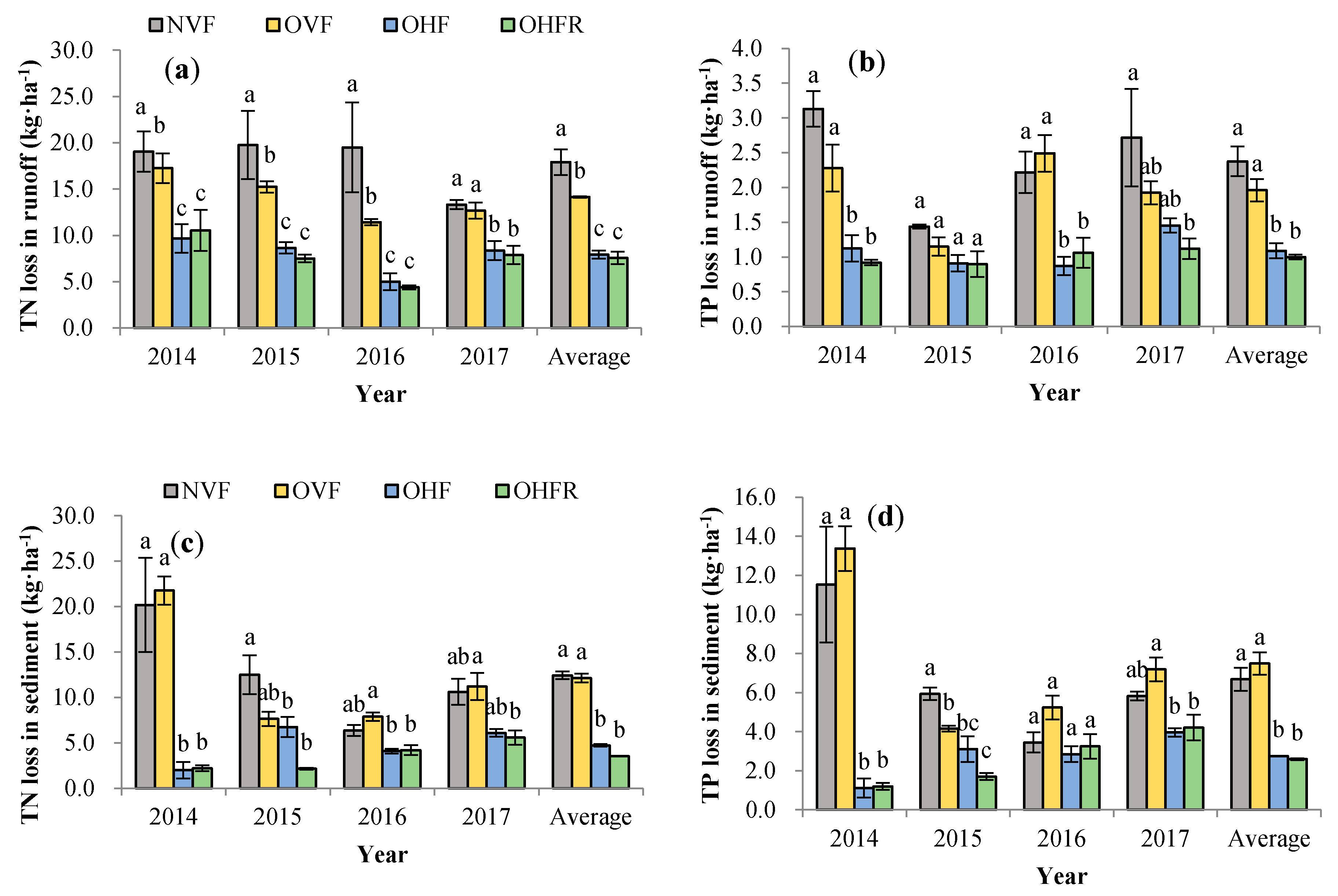
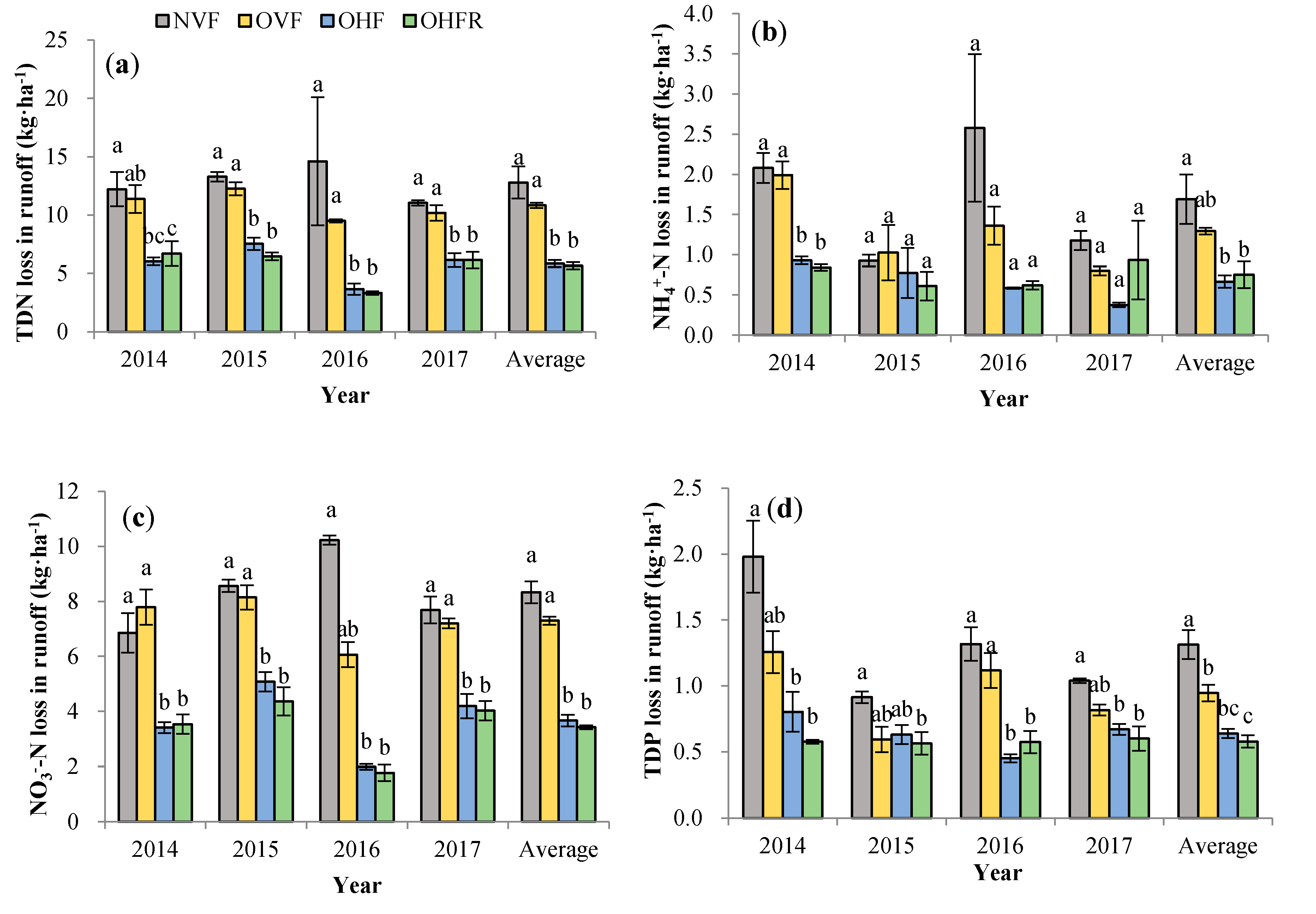
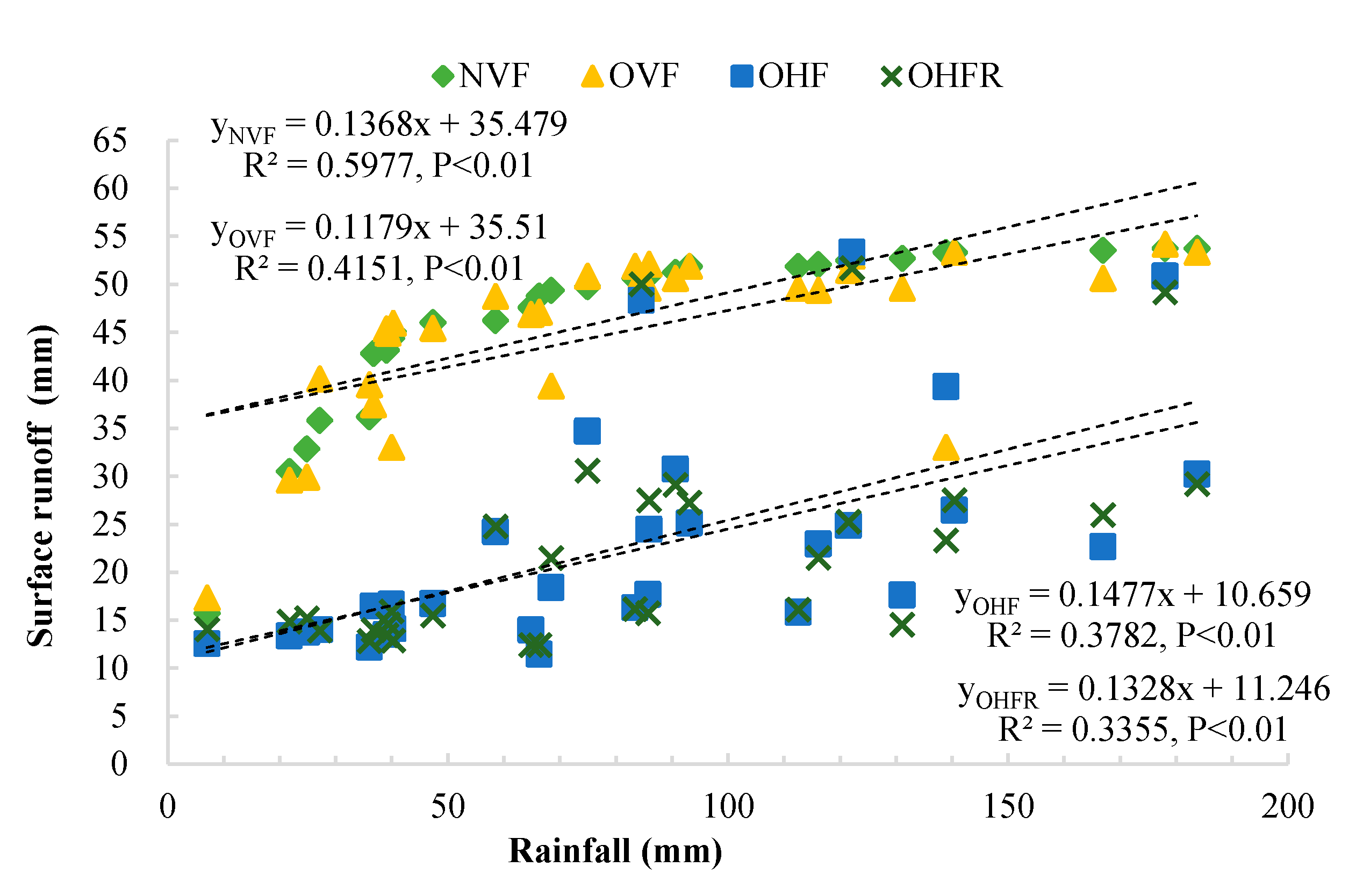
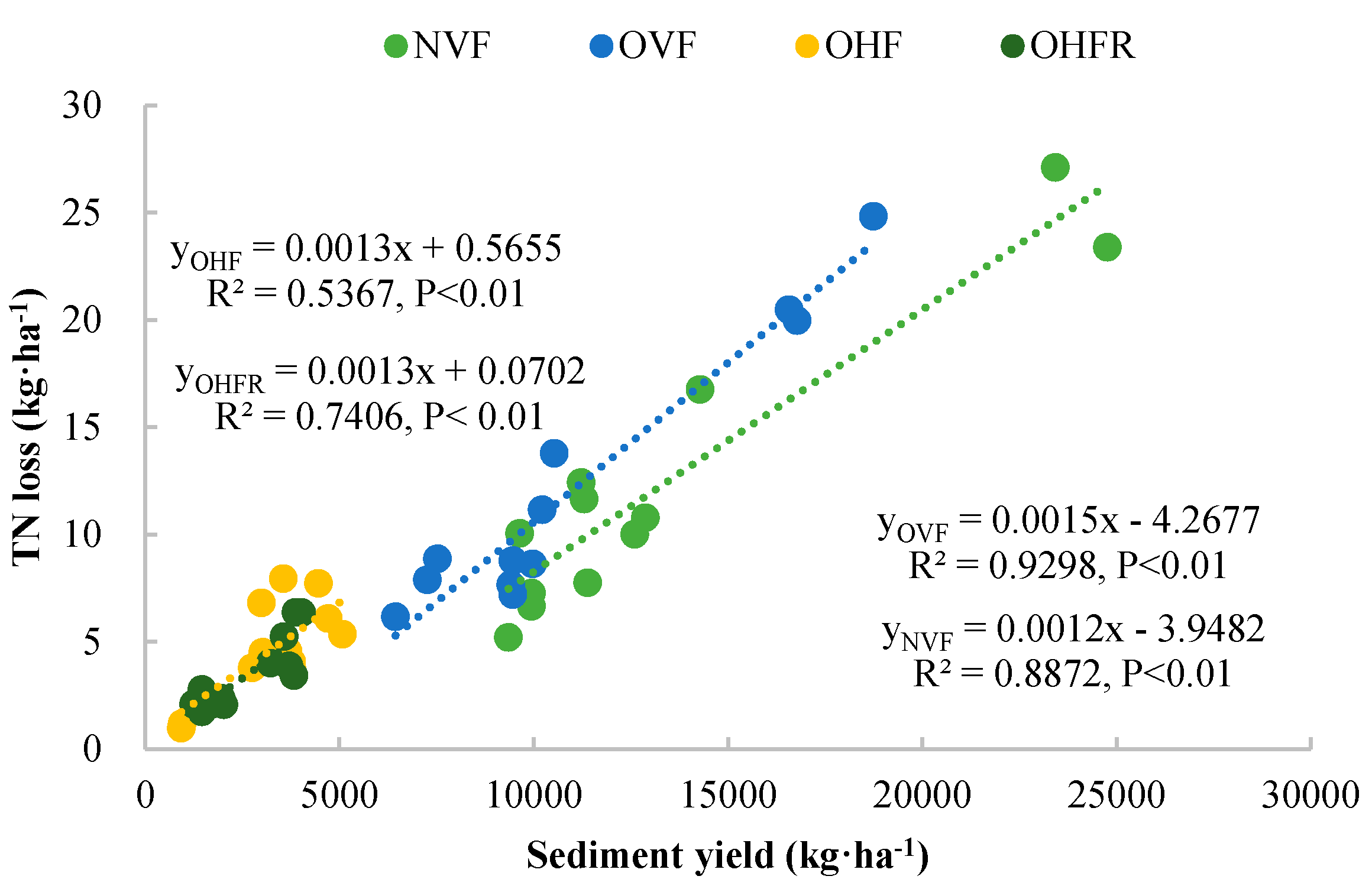

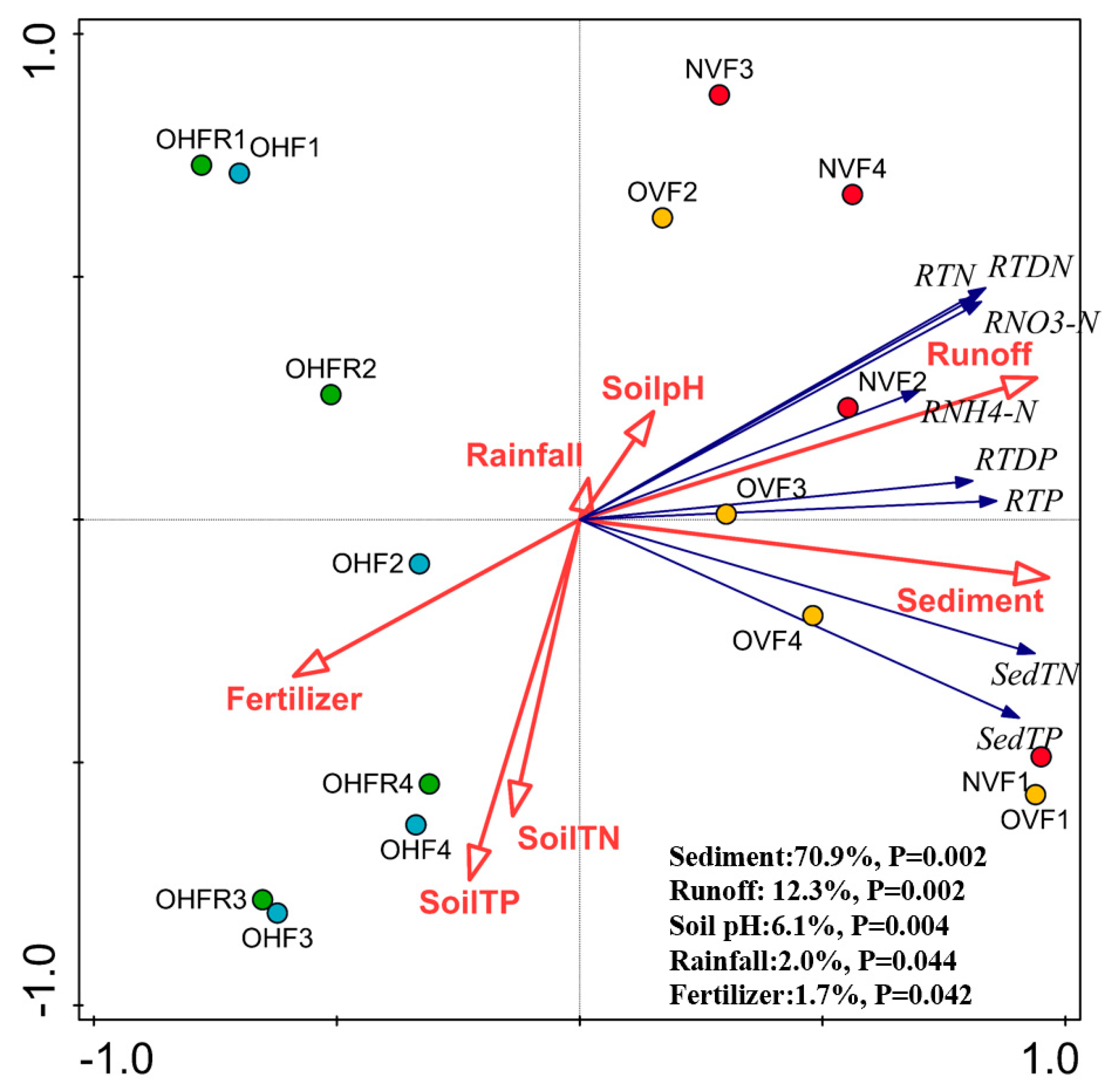
| Treatment | Treatment Group | Description of Treatment | Fertilizer Input (kg·ha−1) | ||
|---|---|---|---|---|---|
| N | P2O5 | K2O | |||
| NVF | VR | No fertilizer application + Vertical ridge + Film covered | 0 | 0 | 0 |
| OVF | VR | Optimizing fertilizer application + Vertical ridge + Film covered | 122 | 131 | 240 |
| OHF | HR | Optimizing fertilizer application + Horizontal ridge + Film covered | 122 | 131 | 240 |
| OHFR | HR | Optimizing fertilizer application + Horizontal ridge + Film removed | 122 | 131 | 240 |
| Group | VR | HR | |||
|---|---|---|---|---|---|
| Treatment | OVF | NVF | OHF | OHFR | |
| ARR% | runoff | 0.0b | −3.43 ± 0.98b | 49.58 ± 1.35a | 50.99 ± 0.64a |
| sediment | 0.0b | −28.00 ± 5.15c | 64.57 ± 1.40a | 72.54 ± 0.85a | |
| TN in runoff | 0.0b | −29.92 ± 8.61c | 43.30 ± 1.75a | 46.73 ± 3.39a | |
| TP in runoff | 0.0b | −26.08 ± 5.73c | 38.83 ± 6.51a | 44.04 ± 5.05a | |
| TN in sediment | 0.0b | −8.88 ± 5.73b | 48.89 ± 1.78a | 64.12 ± 1.28a | |
| TP in sediment | 0.0b | 5.78 ± 2.65b | 51.48 ± 3.97a | 57.10 ± 2.51a | |
| TDN in runoff | 0.0b | −20.08 ± 12.39b | 46.11 ± 1.96a | 47.53 ± 3.46a | |
| NO3−-N in runoff | 0.0b | −20.77 ± 21.25b | 50.43 ± 1.84a | 53.50 ± 0.76a | |
| NH4+-N in runoff | 0.0ab | −42.34 ± 16.82b | 46.26 ± 3.11a | 31.56 ± 14.61a | |
| TDP in runoff | 0.0b | −42.74 ± 4.28c | 24.55 ± 3.63a | 31.50 ± 5.51a | |
| Parameters | Explains % | p Value |
|---|---|---|
| sediment | 70.9 | 0.002 |
| runoff | 12.3 | 0.002 |
| soil pH | 6.1 | 0.004 |
| rainfall | 2.0 | 0.044 |
| fertilizer | 1.7 | 0.042 |
| soil TN | 0.9 | 0.338 |
| soil TP | 0.5 | 0.530 |
| Group | VR | HR | ||
|---|---|---|---|---|
| Treatment | OVF | NVF | OHF | OHFR |
| Runoff | 361.47 ±5.03 A | 373.64 ± 2.72A | 182.28 ± 16.88 B | 177.13 ± 14.44 B |
| TN | 4.04 ± 0.53 A | 4.84 ± 1.22 A | 4.15 ± 0.64 A | 4.18 ± 0.87 A |
| TDN | 3.07 ± 0.38 A | 3.50 ± 0.92 A | 3.06 ± 0.32 A | 3.14 ± 0.48 A |
| NO3−-N | 2.03 ± 0.27 A | 2.28 ± 0.82 A | 1.89 ± 0.26 A | 1.85 ± 0.29 A |
| NH4+-N | 0.38 ± 0.11 A | 0.52 ± 0.23 A | 0.42 ± 0.12 A | 0.50 ± 0.21 A |
| TP | 0.56 ± 0.12 A | 0.64 ± 0.16 A | 0.59 ± 0.11 A | 0.59 ± 0.14 A |
| TDP | 0.27 ± 0.06 A | 0.35 ± 0.07 A | 0.35 ± 0.06 A | 0.33 ± 0.06 A |
© 2020 by the authors. Licensee MDPI, Basel, Switzerland. This article is an open access article distributed under the terms and conditions of the Creative Commons Attribution (CC BY) license (http://creativecommons.org/licenses/by/4.0/).
Share and Cite
Mao, Y.-T.; Hu, W.; Chau, H.W.; Lei, B.-K.; Di, H.-J.; Chen, A.-Q.; Hou, M.-T.; Whitley, S. Combined Cultivation Pattern Reduces Soil Erosion and Nutrient Loss from Sloping Farmland on Red Soil in Southwestern China. Agronomy 2020, 10, 1071. https://doi.org/10.3390/agronomy10081071
Mao Y-T, Hu W, Chau HW, Lei B-K, Di H-J, Chen A-Q, Hou M-T, Whitley S. Combined Cultivation Pattern Reduces Soil Erosion and Nutrient Loss from Sloping Farmland on Red Soil in Southwestern China. Agronomy. 2020; 10(8):1071. https://doi.org/10.3390/agronomy10081071
Chicago/Turabian StyleMao, Yan-Ting, Wei Hu, Henry Wai Chau, Bao-Kun Lei, Hong-Jie Di, An-Qiang Chen, Mei-Ting Hou, and Samuel Whitley. 2020. "Combined Cultivation Pattern Reduces Soil Erosion and Nutrient Loss from Sloping Farmland on Red Soil in Southwestern China" Agronomy 10, no. 8: 1071. https://doi.org/10.3390/agronomy10081071






